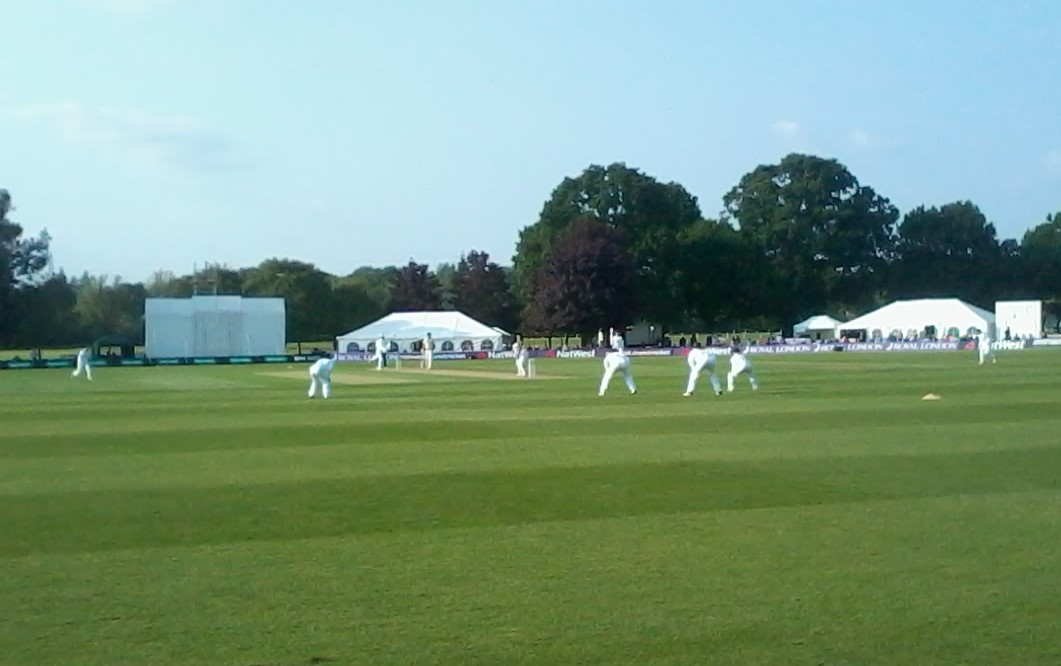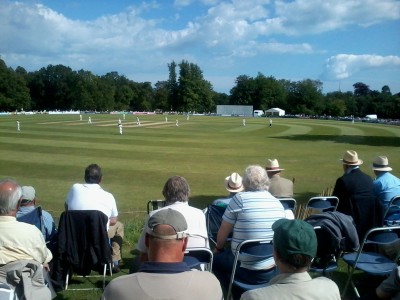One thing in particular my dad cherished about Keith Miller. ‘When he came out to bat’, Dad told me, ‘he used to run down the pavilion steps.’ Dad, like his hero, was an all-round dasher: when he died one of his old clubmates at Alexandra Park CC wrote to us that he was ‘the only man who could bowl the opposition out and then go in and get the runs in time for us all to be home for tea’. Just as the Who in their early days used to run on stage, so that get-after-it spirit should be manifest even on the way out to start your innings.
But at how many major cricket grounds these days are there the pavilion steps even to walk down? Lord’s, of course; the Oval, except that today’s steep switchback – which doesn’t even lead into the pavilion – gives the impression more of negotiating a fire escape. At grounds like Edgbaston, however, the batsmen seem to just wander out of a dark tunnel better suited to the groundsman’s mowers.
Why did early films have their troupes of Busby Berkeley dancers fanning out down a sweeping staircase? Why did Parkinson’s chat-show guests enter down a flight of stairs? Theatre: the building of expectancy. This is why county cricket must return to St Helen’s at Swansea: the anticipatory descent to the outfield from the pavilion high up above Mumbles Bay is cricket’s answer to the staircase scene in Battleship Potemkin. And, for those dismissed for an ignominious duck, we have the Schadenfreude of the endless plod, step by step, back up.
To me such things are important. For a spectator – which is my capacity – cricket is spectacle; theatre. Why not maximise it? As Jon Hotten wrote in Wisden Cricket Monthly reviewing my book The Nature of Cricket alongside Philip Brown’s magnificent compendium of cricket photography, ‘Aesthetic beauty is an important component in sport,’ and ‘cricket has traded on its beauty almost since it began.’ So where has cricket today lost its beauty, and how could it reclaim its aesthetic? Here are a few thoughts.
Is draping a glorified bedsheet over a bank of seats really the best we can do for sightscreens – even at a Test ground? If there is to be coloured clothing at white-ball slogfests (my vote’s not), why do both teams so often wear the same colour? India (blue) v Sri Lanka (blue) – and with all that money . . . And how have we reached the situation where, at showpiece Test matches in this country, de rigeur attire appears to be a nurse’s outfit or even a furry gorilla suit? Would Wimbledon let in people dressed like this? Or the Masters? How does all this look?
I would be more fastidious still. When you think you’ve got the batsman out, you appeal: you ask the umpire, who decides on such things, a question. Howzaaat? Not in the modern game, it seems. You just groan Ugggghhh, as though in flight from a blocked lavatory. Or I’ve heard a wicketkeeper, seemingly under the impression that he’s a crazed inventor, cry Ahh! A-hahhh! As the umpire I’d remain impassive – I haven’t heard an appeal. If pushed I’d counter the incredulity with a prim, ‘Ask nicely . . .’ Caveman utterance is unappealing.
I realise, of course, that cricket is not just there as spectacle for people like me to watch like a film in a cinema: it’s a physical game fought out by the people out in the middle. Some years ago the giant kinesis of the Sussex fast bowler Steve Magoffin practising several full-tilt overs during the tea interval at Tunbridge Wells’s beautiful Nevill Ground, witnessed from just yards away, utterly eclipsed the pretty lilac of the rhododendrons banking the boundary.
However, a doyenne of my profession of book publishing, Diana Athill, used to say that ‘Clarity of expression means clarity of thought.’ All the instances I’ve cited, I’d say, bespeak a carelessness of intention just as much as a gap between bat and pad. What do we want cricket to be?
Decorum comes into it: not the-way-we’ve-always-done-it but a way that has a felicitous logic to it. I find one of the first things I do at a day’s county cricket is check the flagpoles. For both county flags not to be billowing at their masts feels ominous. That they don’t actually need to be there – the visitors, indeed, having to remember to bring theirs – is somehow the point. But also I find it an optimistic sight, recalling Cardus’s reflection that ‘When I think of an innings by Trumper I see in the imagination the unfurling of a banner.’ It defines the nature of the action we hope to see. In everything from Elvis Presleys at Test matches to the overhead ‘ramp’ for six I see decorum replaced by anything goes, and by that logic one day everything will have gone, and we will be at a baseball game.
It dismays me at the Oval therefore (on my rare visits) to come upon all the plastic plants behind the great whaleback of the Vauxhall End. At Hove apparently the plan is to bury the grassy bank at the Cromwell Road End beneath yet another stand and, as a sop to those who’d miss the idyll of watching from deckchairs there, stick down a bit of Astroturf. A melancholy sight recently was the temporary stand for the T20 erected over, to the point of mutilating, Hove’s row of apple trees.
This matters not just for its naffness, never mind ecological uselessness, but because of the bigger message. Trees make cricket grounds, but cricket grounds are becoming stadiums. They’re becoming stadiums because these days they’re really there just for the big showdowns, which apart from Test matches never see a red ball. Even Lord’s, I realised this season, is suddenly a stadium – and it has something to do with no longer being able to see the great plane trees behind the Nursery End (all chopped down to make way for the new space-age stands). Cardus could no longer write about a summer morning at Lord’s ‘when the sky is a blue awning blown out with soft wind, and the trees at the Nursery End make a delicate motion’. And Lord’s is supposed to be in St John’s Wood.
Originally published in County Cricket Matters








